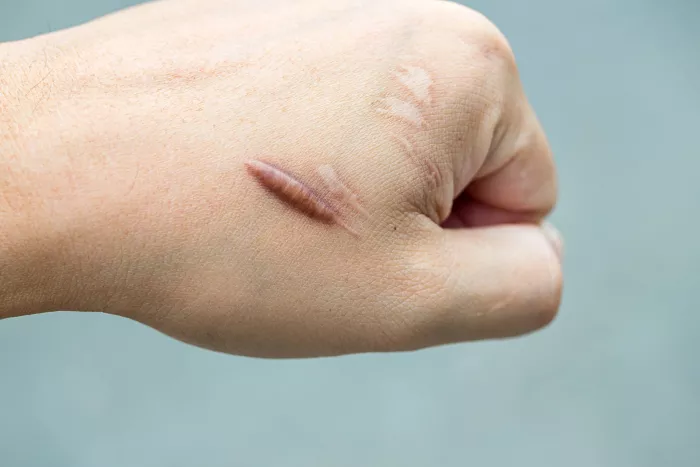Keloid scars are thick, raised scars that grow larger than the original wound. They can be itchy, painful, and affect your confidence. If you’re searching for ways to fix keloid scars, you’re not alone. Many people struggle with these stubborn scars and want effective solutions.
This guide covers medical treatments, natural remedies, and prevention tips to help reduce keloids. Let’s explore the best ways to manage and improve their appearance.
What Are Keloid Scars?
Keloid scars form when the body overproduces collagen during healing. Unlike normal scars, they extend beyond the injury site. They often appear red, pink, or darker than your skin tone and feel firm or rubbery.
Common causes include:
- Acne or chickenpox scars
- Piercings or tattoos
- Surgical cuts or burns
- Minor scratches or insect bites
Keloids can develop weeks or months after an injury. Some people are more prone to them due to genetics.
Medical Treatments for Keloid Scars
Doctors offer several treatments to flatten and fade keloids. The best option depends on the scar’s size, location, and your skin type.
1. Corticosteroid Injections
Corticosteroid shots are the most common treatment. They reduce inflammation and slow collagen production.
How it works: A doctor injects medicine directly into the scar.
Results: Scars soften and flatten after a few sessions.
Side effects: Skin thinning or lightening may occur.
2. Laser Therapy
Laser treatment improves scar color and texture. It works best on newer keloids.
Types: Pulsed-dye lasers (reduce redness) and fractional lasers (smooth texture).
Sessions needed: 2–6 treatments, spaced weeks apart.
Recovery: Mild redness or swelling for a few days.
3. Cryotherapy
Freezing the scar with liquid nitrogen can shrink small keloids.
Process: The doctor applies extreme cold to destroy excess tissue.
Effectiveness: Works best on small, early-stage keloids.
Downside: May cause temporary skin lightening.
4. Surgical Removal
Surgery cuts out the keloid but has a high recurrence rate.
Best for: Large, stubborn keloids.
Combined with: Radiation or injections to prevent regrowth.
Risks: The scar may come back bigger.
5. Radiation Therapy
Low-dose radiation prevents keloids from returning after surgery.
How it works: Targets remaining scar cells to stop regrowth.
Safety: Used in small doses to minimize risks.
Effectiveness: Lowers recurrence when paired with surgery.
6. Silicone Gel or Sheets
Silicone products hydrate and flatten scars over time.
Application: Wear sheets for 12+ hours daily or apply gel.
Results: Visible improvement in 2–6 months.
Best for: Preventing keloids after surgery or injury.
Home Remedies for Keloid Scars
If you prefer natural treatments, these home remedies may help.
1. Onion Extract
Onion extract (found in gels like Mederma) reduces scar thickness.
How to use: Apply 2–3 times daily for weeks.
Science: Contains anti-inflammatory compounds.
2. Honey
Honey moisturizes and may reduce keloid size.
Best type: Raw, medical-grade honey.
Application: Apply a thin layer, cover overnight, rinse in the morning.
3. Aloe Vera
Aloe soothes skin and may prevent excessive scarring.
Method: Use fresh gel or pure aloe products daily.
Bonus: Reduces itchiness and redness.
4. Apple Cider Vinegar
Diluted ACV may lighten and soften scars.
Mix: 1 part vinegar, 2 parts water.
Apply: Dab on the scar, leave for 10 minutes, then rinse.
5. Tea Tree Oil
Tea tree oil has anti-inflammatory properties.
Caution: Always dilute with a carrier oil (like coconut oil).
Use: Massage into the scar 1–2 times daily.
6. Baking Soda Paste
A gentle exfoliant that may reduce scar thickness.
Recipe: Mix baking soda with water to form a paste.
Apply: Gently rub on the scar, rinse after 15 minutes.
How to Prevent Keloid Scars
If you’re prone to keloids, take these steps to avoid new ones:
- Avoid unnecessary piercings or tattoos.
- Treat acne promptly to prevent deep scars.
- Use silicone sheets on healing wounds.
- Keep wounds moist with petroleum jelly.
- Avoid sun exposure, which darkens scars.
When to See a Doctor
Try home remedies first, but consult a dermatologist if:
- The keloid is painful or growing.
- Home treatments don’t work after months.
- You want faster, more effective solutions.
Conclusion
Fixing keloid scars takes patience. Medical treatments like injections and lasers offer faster results, while home remedies are gentler and cheaper. Combining both methods may give the best outcome.
If you’re struggling with keloids, don’t lose hope. With the right approach, you can reduce their appearance and feel more confident in your skin.
Related topics:
Can Plastic Surgeons Remove Scars?
Will microdermabrasion help acne scars?
What is better for acne scars microdermabrasion or microneedling?

